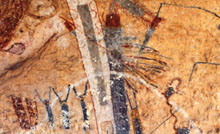The pictographs of the Pecos River have lasted millennia in a tempestuous desert, surviving mostly in silence. Now an archaeologist has cracked the code — and they can begin to speak again.
September 12, 2012, was a long day, but a good one. For Carolyn Boyd it started with a 30-minute drive from her home in Comstock to a 265-acre preserve, where she convened with fellow archaeologists Mark Willis and Amanda Castaneda and left the road behind. From there it was a half-hour walk on a well-worn trail traversing cactus-strewn stone. The ladder they carried made for awkward hiking, but the cool fall morning helped compensate. By 8:30 a.m. they had climbed down from the scrubby plateau and arrived at a shallow, mouth-shaped indentation near the top of a rough cliff overlooking the Pecos River. Just downstream, occasional cars and semis hummed across the 1,310-foot bridge that carries U.S. Highway 90 over the river, almost 300 feet below. A little more than a mile downstream, the Pecos slipped quietly into the Rio Grande.
The mouth-shaped indentation was well known, the site of an elaborate expanse of prehistoric painted rock art known as the White Shaman mural, after its spectral central figure. Boyd had been to the shelter maybe a hundred times, but this was the first time she had come equipped with a $500 Dino-Lite digital microscope… Read more from the Texas Observer

